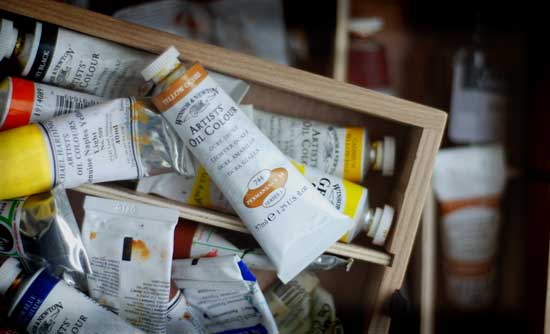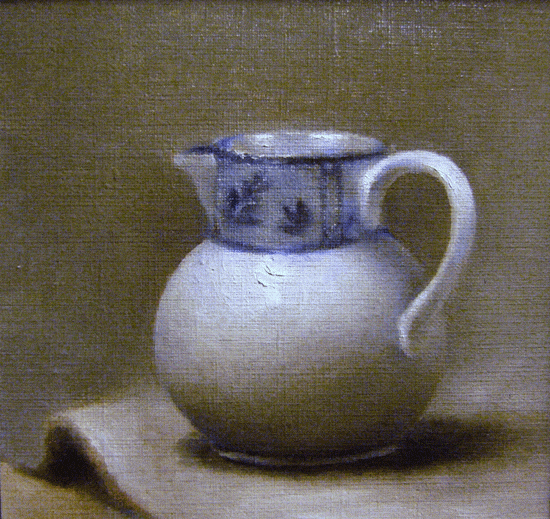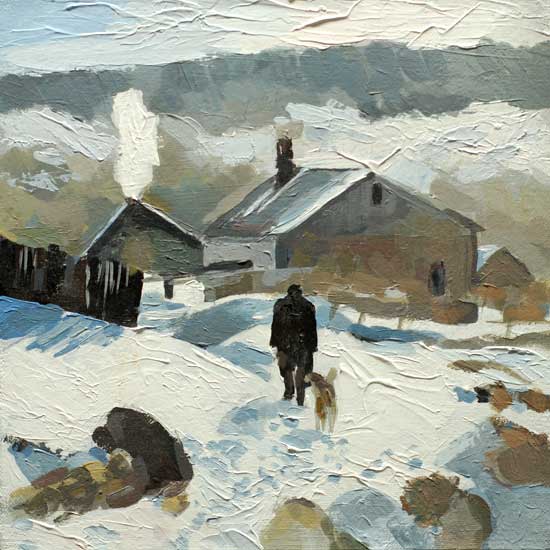What Kind of Thinking Goes Into Painting and Art

"I am a simple man, and I use simple materials: Ivory black, Vermilion (red), Prussian bluish, Yellow ochre, Fleck white and no medium. That's all I've ever used in my paintings.
50.S.Lowry
A cracking deal of things in nature are actually very muted, it is often the difference between lite and dark and warm and cool colours, rather than the utilize of a bright colour.
If you desire to paint subtle still life paintings, choose muted world colours.
If you lot want very bright, vivid abstracts, y'all might need some more human being-made pigments that have a higher colour saturation.
My suggested basic acrylic color palette is somewhere in-between. It allows bright colour mixtures as well equally subtle. The pigments are all light-fast (will not fade over time) and are a mixture of series (the price labelling arrangement of paints) so the cost will be kept downward….
In his book "Blue and Xanthous don't make Green", Michael Wilcox talks extensively well-nigh the colour bias of pigment.
Colour bias happens due to the trace colours constitute in paint pigments. They can cause trouble when trying to mix bright clean colours when you use the wrong pigment pigments.
One way to overcome this trouble is to take a palette that consists of two of each of the chief colours, red, xanthous and blue.
He recommends a palette of 6 colours, 2 primaries each.
A red with an orange bias for mixing orange – Cadmium Ruddy
A red with a violet bias for mixing violet – Quinacridone Red
A yellow with orange bias – Cadmium Yellowish
A yellow with green bias – Hansa Xanthous
A blue with dark-green bias – Cerulean Blue
A bluish with a regal bias – Ultramarine Blue
Yet, I find in do, peculiarly if yous are just starting acrylic painting, this can be a tad overwhelming.
How to start with three tubes of paint
Now I know you are going to remember this is a misprint but I would usually recommend starting with iii tubes of paint consisting of a warm and a cool colour.
- Burnt Umber (muted orange based brownish) or Burnt sienna (brighter orange based brownish)
- Ultramarine blue
- Titanium white
But what happened to the chief colours?
A slap-up lesson you need to learn when trying to create professional looking paintings is the importance of value (how dark or light a discipline is)
It is and then much more important than color. Try to acquire about value, acquire about complementary colours (opposites) and y'all will start to sympathise the different qualities of paint.
Moving from drawing to painting is hard enough without the distraction of trying to mix lots of colours if you force yourself to have less you volition learn more about mass tone and undertone.
Masstone & Undertone
- Colour – has both a masstone and an undertone
- Masstone – refers both to the tone if information technology was blackness and white (value) and its colour tone (hue).
- Undertone – the colour produced when you scrape a minor corporeality of paint over a white surface
eg: Phthalo blueish has a dark blue masstone and a yellow/green colour bias in undertone
Then if I say, "look at the tonal range in this painting," this is exactly the aforementioned as saying "await at the value range in this painting."
You lot'd be amazed at the peachy paintings you can achieve with merely a few colours. The painting below by Larine Chung uses simply ultramarine blue, burnt sienna and titanium white.
 In this snowy scene "Coming Domicile" I've used burnt umber, ultramarine blueish and titanium white.
In this snowy scene "Coming Domicile" I've used burnt umber, ultramarine blueish and titanium white.
Okay, I sympathise this but information technology sounds serious.. I want bright colours!
If you really want to become started with color, beneath I've listed a bones acrylic color palette that will assistance you achieve the next level in your painting.
What acrylic colours should I buy to start with?
To create xc% of the colours you will need for realistic painting apply the following:
- Burnt Umber
- Ultramarine Blueish
- Cadmium Yellow Calorie-free
- Alizarin Crimson Permanent
- Titanium White
Other useful colours:
- Yellow Ochre
- Raw Umber
- Ivory Blackness
- Cadmium Scarlet
- Phthalo Blue (Greenish Shade)
Why do I demand these particular colours?
Burnt Umber – although this looks very dark and deadening it is actually handy to have, both for blocking in the darks on portraits and for toning down colours. It is as well invaluable in oil painting due to its quick drying time so it is a bang-up pigment to go to know.
Ultramarine Bluish – sometimes beginners steer away from this blue because it is mentioned so frequently in art books and seems, well a flake boring, simply it has expert opacity, peachy for subtle skies and mixed with Burnt Umber will make a dark very shut to black.
Cadmium Yellow Lite – good opacity for a yellowish and simply generally bang-up!
Alizarin Ruby Permanent – this will await likewise dark when y'all buy information technology and y'all'll feel a bit disappointed, it also feels dissimilar than the other pigments considering it has a gloss sheen to it and it very translucent. Merely a little goes a long way. Add some white to make a killer bright pink.
Titanium White – good opacity, good coverage, goooood.
Pro tip: make sure it is the permanent every bit other Alizarin Crimsons can be 'avoiding' colours and not have great lightfastness. Look at some of Gainsboroughs portraits to see what happens if you use avoiding colours.
Now with these four colours and white you tin mix ninety% of the colours y'all need. You lot might not believe me and still experience the urge to search for another palette. But for general landscapes, notwithstanding life's you won't need anything else.
Occasionally you lot volition need iii other colours, they are:
Phthalo Bluish (greenish shade) very high tinting forcefulness, great for making very bright blues.
Cadmium Ruddy Light – if you lot desire a actually blood-red red. Cadmium Yellowish light and Alizarin crimson permanent can make a color very close to cadmium scarlet.
Xanthous Ochre – So here nosotros have yellow ochre neat for a coloured footing in acrylics and skilful to outset to mix more subtle greens, if you unleash Hansa yellowish and Phthalo bluish we will have luminous greenish disasters.
These are pigments that volition work well both with acrylic and oil paint. It makes it very transferable when you are learning to paint. For a watercolour palette you may choose some more subtle tints that have a different undertone.
For a portrait palette I would use a more than subtle palette delight see:
How to choose a bones portrait palette for Oils
Yous might also similar:
i.Titian's use of warm and cool colours
two.The hidden hues of colour mixing
Source: https://willkempartschool.com/how-to-choose-a-basic-acrylic-palette-for-colour-mixing/

0 Response to "What Kind of Thinking Goes Into Painting and Art"
Enviar um comentário